The 63rd New York International Antiquarian Book Fair (April 27-30, 2023 at the Park Avenue Armory) will feature over 180 exhibitors from 17 countries, presenting a vast treasure trove of items: rare books, maps, illuminated manuscripts, incunabula, fine bindings, illustrations, historical documents, prints and print ephemera. Below are some of the items dealers have indentified as their finest or most-exciting offerings!
Publisher's Deluxe Edition with the Plates Colored by Hand A Wonderful Example in the Publisher's Superlative 'Polychromatic' Binding
SAND, Maurice; MANCEAU, A, illustrator
Masques et Bouffons (Comédie Italienne). Texte et Dessins par Maurice Sand. Gravures par A. Manceau. Preface par George Sand.
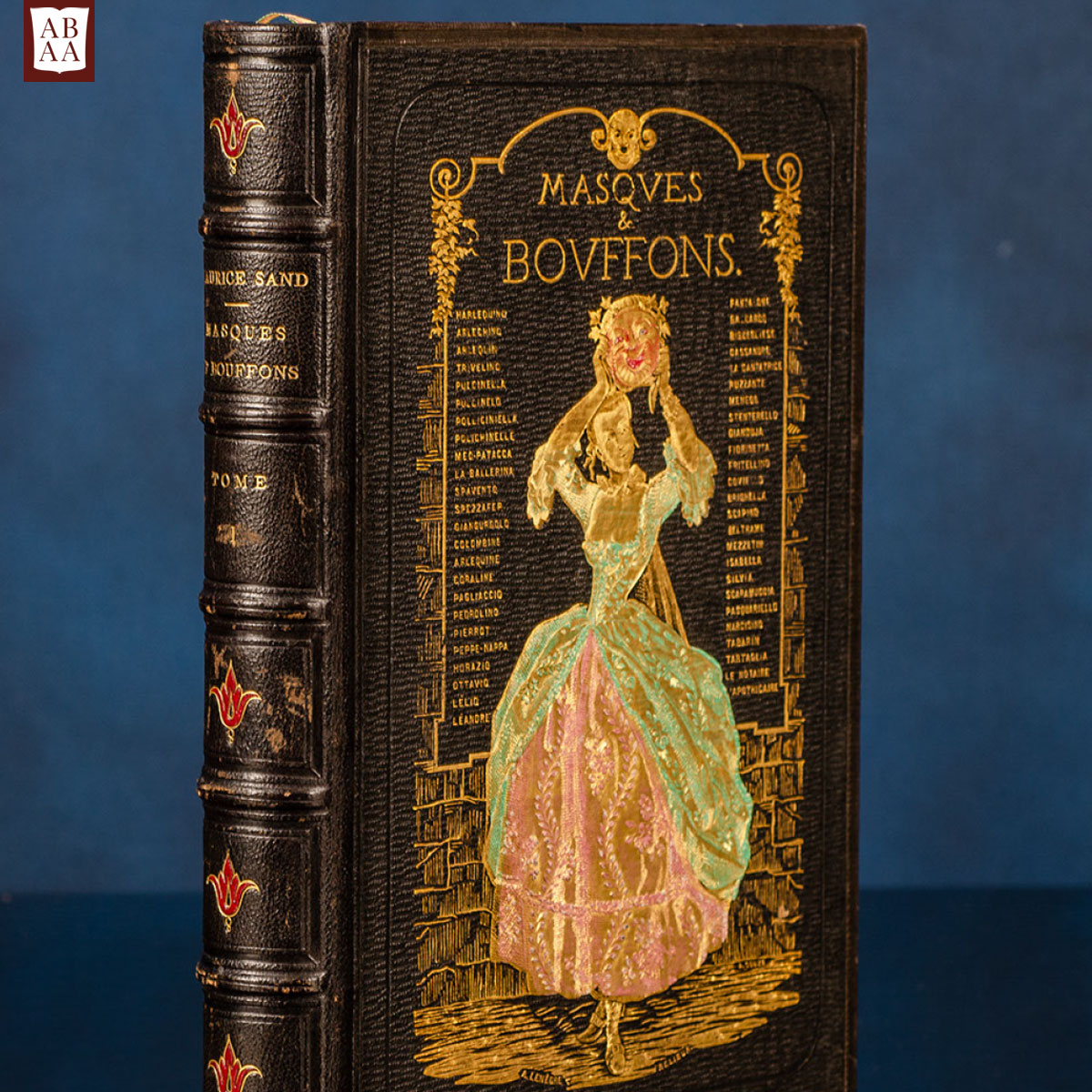
Paris: A Lévy Fils, Libraire-Éditeur, 1862. Publisher's Deluxe Edition in the Superlative 'Polychromatic' Binding by Antoine Lenègre. Two large octavo volumes (10 3/8 x 7 1/8 inches; 263 x 181 mm.). -viii, 356,[2] list of plates,verso blank], [2], table, verso blank] pp; [iv], 384 pp. Half-titles with printer's credit and publisher's note verso and printed titles in red to each vol., engraved frontispiece with additional coloring by hand to vol. 1, 'Préface' by George Sand, 'Avant-Propos', 'Introduction' and text. Fifty superb hand colored plates by Maurice Sand, and engraved by George Sand's lover Alexandre Manceau.
Publisher's Deluxe 'Polychromatic' binding by Antoine Lenègre with his signature in gilt on both front covers. Quarter black chagrin over black cloth boards with highly elaborate polychromatic decoration, upper covers ruled in blind to surround an elaborate gilt vignette in gilt, red and green ('La Comédie' from the Commedia dell'Arte raising her mask after the frontispiece to vol. one) beneath title and flanked by the gilt names of other characters. Spines with five raised bands, four panels with inlaid red morocco flowers outlined in gilt, the remaining two panels lettered in gilt, marbled endpapers, all edges gilt. Housed in the original? marbled board slipcase.
A wonderful example with the plates colored by hand - in the deluxe issue of the publisher's polychromatic binding.
This history of the characters and roles of the Commedia dell'Arte was written and illustrated by Jean-François-Maurice- Arnauld Dudevant, better known by his pseudonym, Maurice Sand (1823-1889), a name adopted after his mother's literary pseudonym, George Sand (1804-1876). A writer, artist and entomologist, Maurice Sand studied under Delacroix. His mother, George Sand (Amantine Lucile Aurore Dupin) wrote the introduction and her lover Alexandre Manceau (1817-1865), a friend of her son's and many years her junior, engraved the plates after Maurice Sand's originals. This exceptional example demonstrates the remarkable publisher's binding to superlative effect.
Loosely laid-in to volume one before the frontispiece is a letter to his mother in which he relates a part of his visit to the United States of America with Prince Napoleon.
Provenance: With the small square engraved bookplate of Dr. Armand Ripault "D’espérer servir".
According to Colas and Carteret, the work was issued in several versions: with the plates in black, with the plates in red and with the plates with additional color by hand; the present version has the title dated '1862 and the plates with additional color by hand… "Ces planches existent coloriees ou non; il y a deux couvertures differentes: l'une verte impr. en bistre et noir avec le titre ci-dessus; l'autre saumon impr. en rouge et noir avec l'adresse modifiee comme suit: Paris, A. Levy fils, libraire-editeur, 29, rue de Seine 1862." (Colas, p. 948).
Antoine Lenègre (1818-1867). Parisian binder who specialized in la Relieure Industrielle or this style of binding known in French as Cartonnage de l'Éditeur. These elaborate original publisher's cloth bindings are signed "A. Lenègre Relieure" within the elaborate gilt work on the front covers.
Alexandre Manceau (1817-1865). French designer and engraver who was a great admirer of George Sand. He wrote and designed the fifty Masks for the Masques et Bouffons (Comédie Italienne) which was first published in 1860 by Michel Levy Frères.
Offered by David Brass Rare Books (booth B2).
The Hours of Jean Antoine de Mahieu & Jacqueline de Sivry (use of Mons)
In Latin and some French, illuminated manuscript on parchment, Southern Netherlands, Mons, c. 1460 (original portion), c. 1480-1490 (updated).
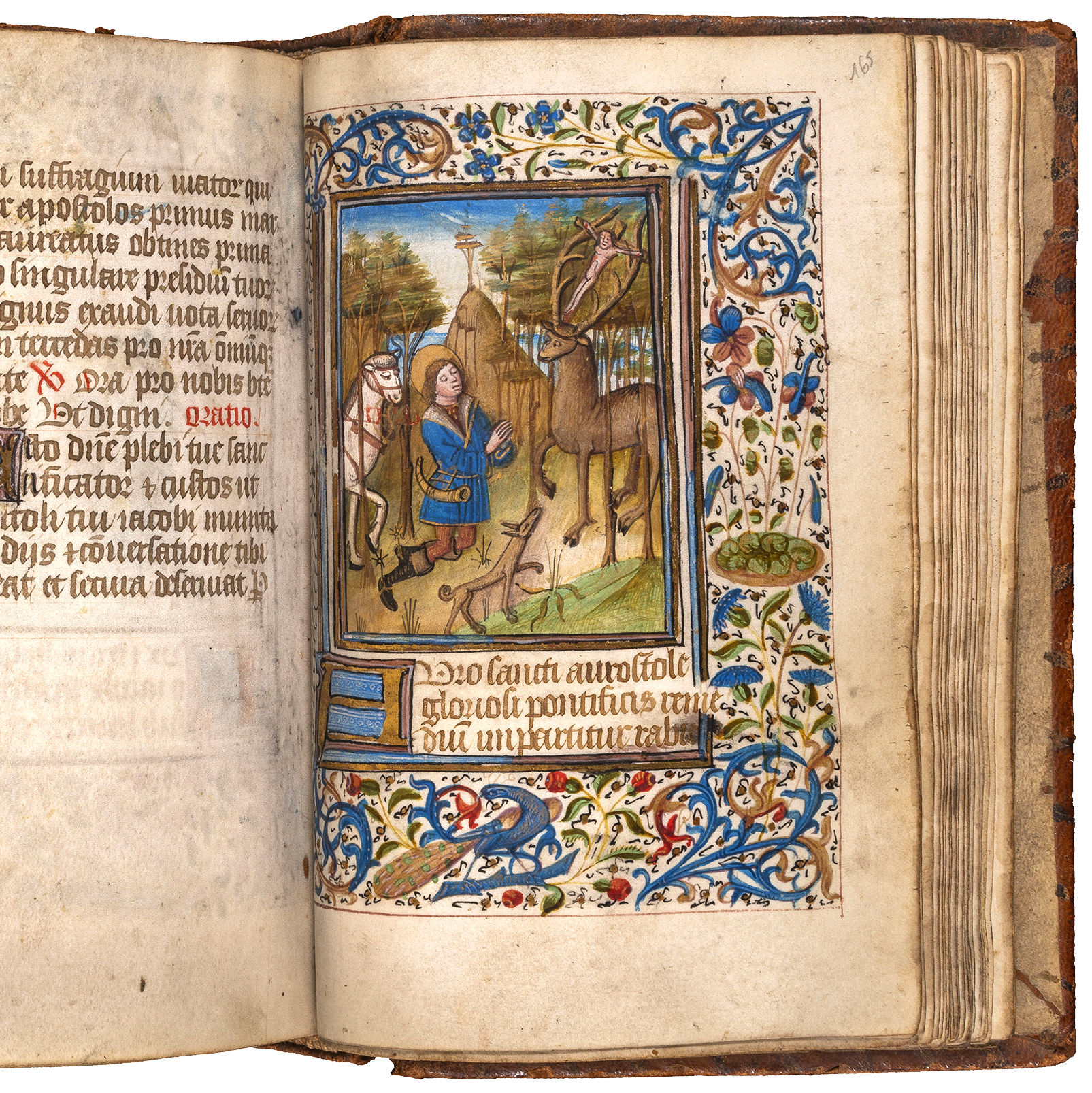
This is a fascinating Book of Hours with an extensive cycle of illuminations by three different artists. It offers an excellent case study of how Books of Hours were customized for the special devotional needs and artistic taste of owners even within a generation of each other. Made of an unknown patron (a woman) around 1460, the original manuscript was updated only about a decade later for Jean Antoine de Mahieu, Lord of Bosqueau, and his wife, Jacqueline de Sivry, Lady of Buath, in Mons. From the best of the three artists, they ordered a lovely miniature with their portraits and arms, announcing their ownership, and paying tribute to a local hero, Simon Marmion.
Offered by Les Enluminures (booth D15).
ANDREAS VESALIUS. De humani corporis fabrica libri septem.
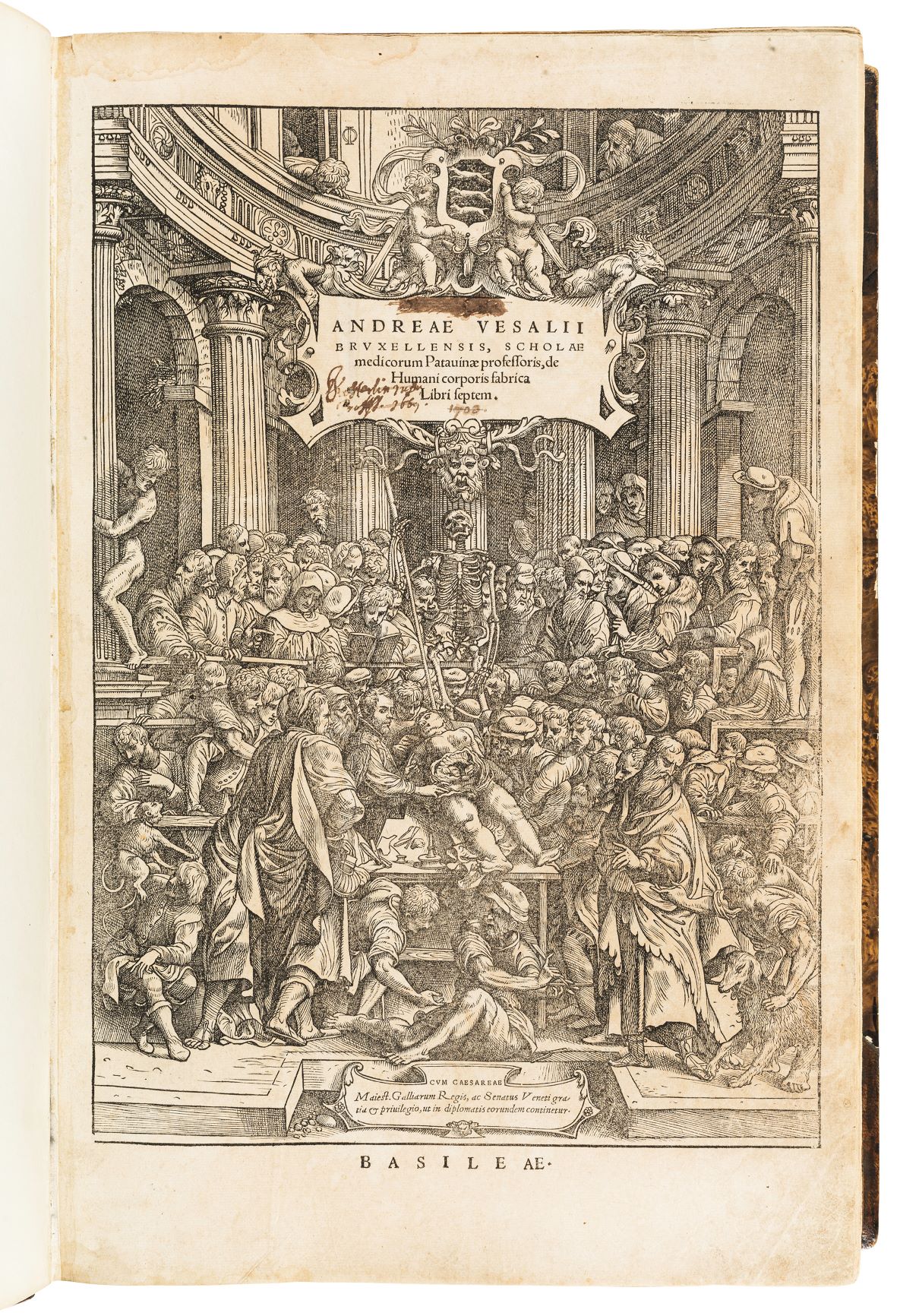
Basel, Johannes Oporinus, June 1543.
FIRST EDITION OF THIS“EPOCHAL PUBLICATION,ONE OF THE MOST BEAUTIFULSCIENTIFIC BOOKSEVER PRINTED” (Grolier/Horblit).
“With De humani corporis fabrica, published when he was only twenty-nine years old, Vesalius revolutionized not only the science of anatomy but how it was taught. Throughout this encyclopaedic work on the structure and workings of the human body, Vesalius provided a fuller and more-detailed description of human anatomy than any of his predecessors, correcting errors in the traditional anatomical teachings of Galen ... The Fabrica also broke new ground in its unprecedented blending of scientific exposition, art and typography. Although earlier anatomical books, such as those by Berengario da Carpi had contained some notable anatomical illustrations, they had never appeared in such number or been executed in such minute precision as in the Fabrica, and they had usually been introduced rather haphazardly with little or no relationship tothe text ... The book remains the masterpiece of Johannes Oporinus of Basel, one of the mostwidely learned and iconoclastic of the so-called 'scholar-printers', whose success with this book apparently caused Vesalius to entrust to Oporinus all of his alter publications ... Although the illustrations have traditionally been attributed to an associate of Titian, Jan Stephan von Calcar who drew and possibly engraved the three woodcuts of skeletons in Vesalius first series of anatomical charts, Tabulae antomicae sex (1538), there is no reliable basis for this attribution. Modern scholarship attributes the Fabrica woodcuts only to an unknown artist or artists in the school of Titian. Vesalius commissioned the illustrations and supervised their production” (Norman). “It cannot be emphasized too often that this was an epochal book. The beautiful woodcuts, executed under the supervision of Vesalius by the artists Jan Stephan van Calcar, student of Titian, are famous for their beauty, accuracy and lavishness of detail and number. It was E. Jackschath of Tilsit who pointed out that the background scenes of the 'muscle men' illustrations are, when collected into a continuum, a dioramic replica of the Paduan countryside of the time ofVesalius ... This first edition of the Fabrica is the heart of any library of medical history” (Heirs of Hippocrates).
Folio (427x283 mm). [12], 659 [recte 663], [1], [36] pp. (313-491 misnumbered 213-391 and pp. 662-663 misnumbered 658-659). *6; A-Z6 a-l6 m6+1, n-o6 p4+1, q-z6 Aa-Ll6 Mm8. With the two folding sheets signed m3 and p4, and the single leaf inserted in quire m ('Charta parvas aliquot figuras complectens', signed m3). Roman and italic types, occasional use of Greek and Hebrew types, printed shoulder notes. Woodcut pictorial title, author portrait, and printer's device; 7 large, 186 mid-sized, and 22 small woodcut initials; more than 200 woodcut illustrations, including 3 full-page skeletons, 14 full-page muscle-men, 5 large diagrams of veins and nerves, 10 mid-sized views of the abdomen, 2 mid-sized views of the thorax, 13 mid-sized views of the skull and brain, and numerous smaller views of bones, organs and anatomical parts.
Nineteenth century half calf, author's name gilt on spine.
Old restorations to the binding. Marginal dampstaining throughout, extending in the last leaves, one or two small wormholes in the margins at the beginning and end of volume. One of the folding sheets with small tear to fold. Title shield of the frontispiece with tiny holes caused by cancellation of ownership entries in ink (no loss). Printer's device on last leaf cut out and mounted.
Offered by Erasmushaus (booth B12).
THE DESIGN ARCHIVE OF ALEX STEINWEISS, INVENTOR OF THE ALBUM COVER
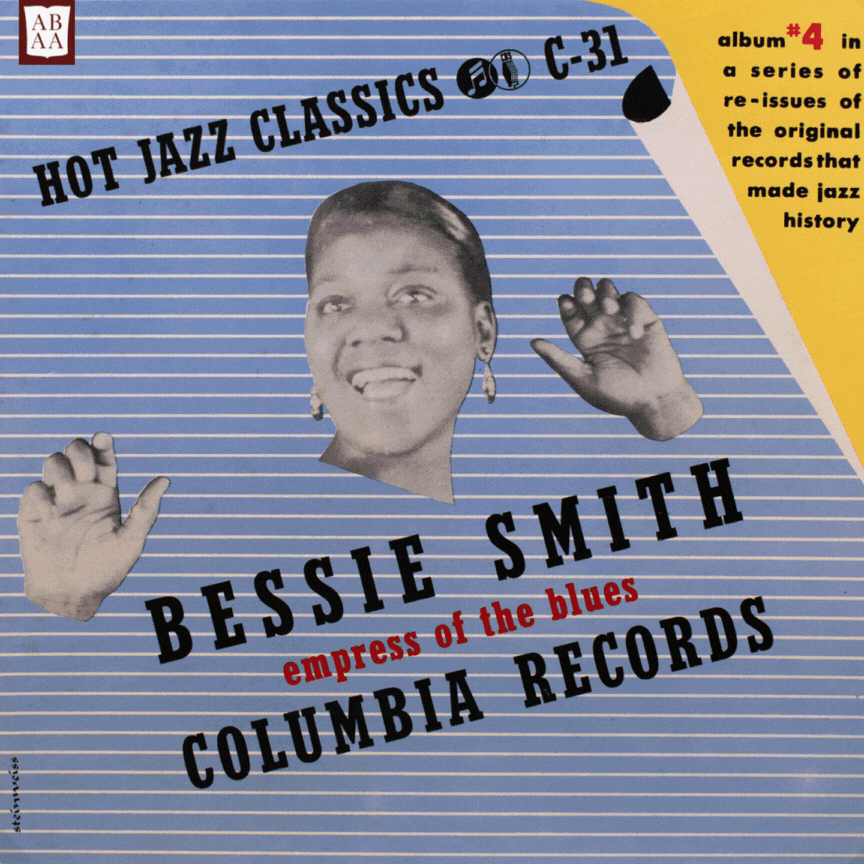
In 1939, Alex Steinweiss, a young graduate of Parsons School of Design and the new art director at Columbia Records, added graphic elements to the drab covers of binders housing sets of 78 rpm discs, an innovative idea that soon changed how recorded music was marketed. After the war, Steinweiss (1917-2011) founded his own design studio and maintained an association with Columbia. He was uniquely poised to act when the 33-1/3 LP record was introduced in 1948. He integrated these stylish miniature posters with a cardboard sleeve and invented the illustrated album cover, which remained the multimedia package accompanying recorded music until the advent of the music CD. Steinweiss designed hundreds of record covers for Columbia, as well as for other labels like Decca and London records. Over three decades, he produced thousands of these stylish and even iconic designs, often lettered with his signature scrawling calligraphy.
The first illustrated album cover was for Smash Hits By Rodgers & Hart (1939). Designs by Steinweiss appeared on albums of all types of music, mainly in classical, pop, and jazz, ranging from Stravinsky’s Firebird suite and Le Sacre du Printemps to Porgy and Bess and Cole Porter, as well as illustrating notable albums by Paul Robeson, Bessie Smith, and Louis Armstrong, and creating the art for Bill Haley’s Rock around the Clock and Happy Jack by The Who.
Steinweiss received numerous awards for his work, and in 2003 the Alex Award for excellence in media packaging was named in his honor. Two published books have drawn upon the archive: For the Record: The Life and Work of Alex Steinweiss (Princeton Architectural Press, 2000) and Alex Steinweiss: The Inventor of the Modern Album Cover (Taschen Books, 2009).
The Archive of Alex Steinweiss comprises more than 1,000 of his conceptual sketches (original ideas for the design projects), more than 2,500 printed proofs of album covers, together with more than 1,000 pieces of ephemera and original artwork from industrial design work that Steinweiss did within the record industry and in other commercial fields, as well as photographic slides, prints and negatives, files of correspondence, and books and magazines documenting his work.
Materials from the Archive of Alex Steinweiss will be on view at the New York International Antiquarian Book Fair, in the booth of James Cummins Bookseller (X1), 27-30 April at the Park Avenue Armory. An illustrated catalogue is available.
Offered by James Cummins Bookseller (booth A1).
Castaing, John. The Course of the Exchange, and Other Things.
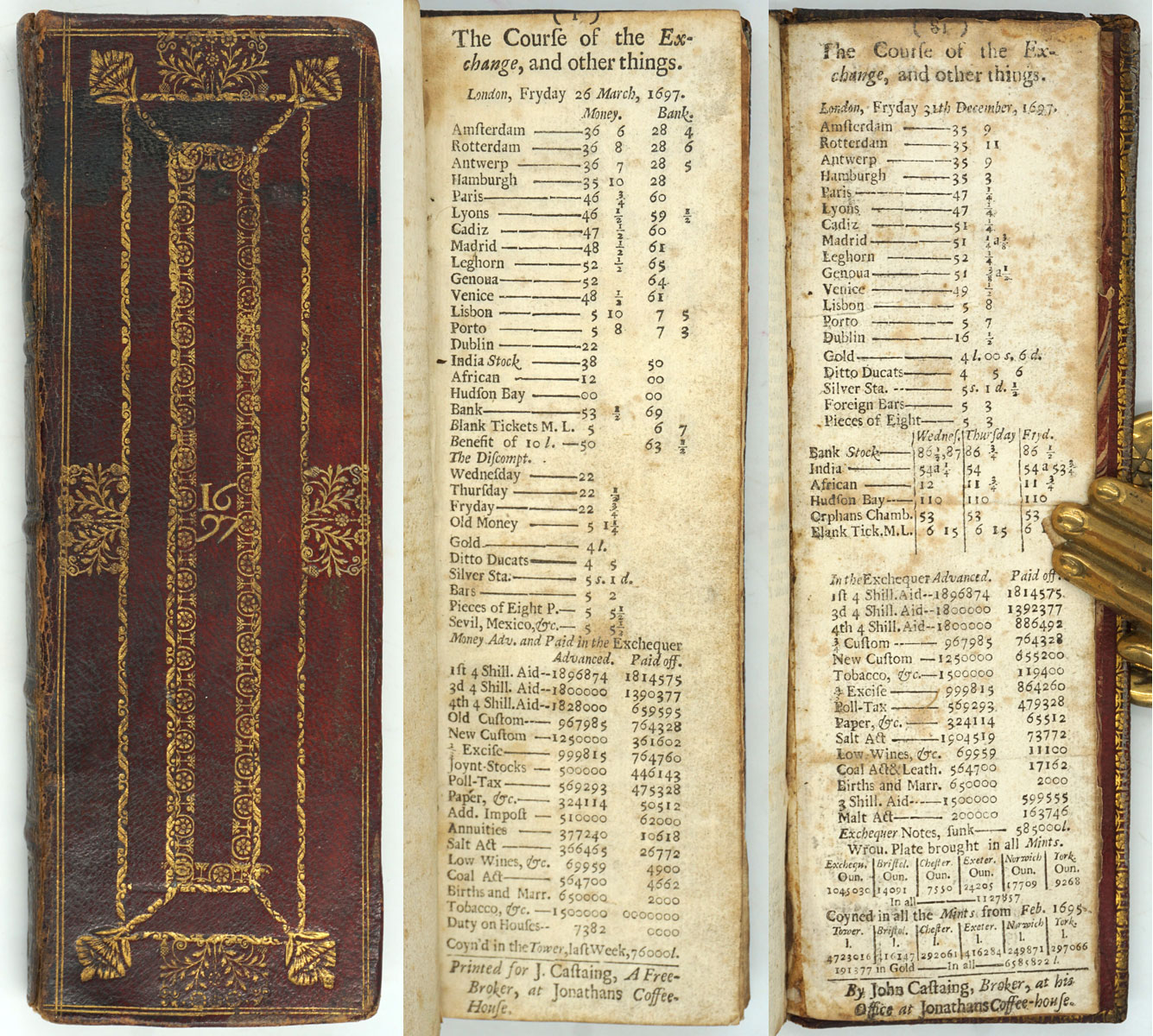
London: John Castaing, A Free-Broker, at Jonathan's Coffee House, 1697. First edition.
The only known copy of the first year of "The Course of the Exchange", the genesis of "The Stock Exchange Daily Official List" still published in London today over 300 years later. It is the longest running financial periodical continuously printed in the world.
John Castaing was a French Hugenot who fled France after the Edict of Nantes was revoked in 1685 by Louis XIV. French Protestants flocked to London along with Dutch financiers who came in the train of the new English King William III, the Prince of Orange. Issues of the war with France, the founding of the Bank of England, the currency reforms and eventually the elimination of the license for publishing in 1695 lead to an explosion of commerce and publishing. Castaing was comfortably ensconced in the Hugenot community around Soho by the mid 1680s. He was a broker and successful publisher before this effort. He offered something very new, combining stocks and shares, exchange rate currents, money exchange, etc. in one convenient place. An interested party could have the financial information more conveniently, twice as frequently and at half the cost of other newspapers.
This copy is bound in period 17th century binding identical to the most complete sets which are found in the British Library & Guildhall Libraries - full maroon leather with gold tooling on the covers and the spine and gilt-edged pages. It is sized to fit in a broker's pocket, just 3" wide by 8 1/2" tall. The Kress Library of Business and Economics in the Baker Library, Harvard University, also have some holdings in this binding.
There is a period ownership signature "James Wetenhall" on ffep. The publisher from 1786 and after was one Edward Wetenhall & Harvard holds an 1822 copy published by James Wetenhall. We presume that John Wetenhall was some relation of Edward. Harvard ( Goldsmiths'-Kress Serials number 3567 - 3568; OCLC: 1235461725.)
Castaing's reputation as a publisher was one of respect for the great accuracy of his Currents. The publication was directly controlled by the family for over 80 years. McCusker and Gravesteijn go to great lengths to identify the publishers between 1697 to 1786 and after. Beginning with John Castaing (1697-1707); to his son John Castaing Jr. (1707-1725); thence to John Castaing Jr. and Edward Jackson (1725-1729); on Castaing Jrs death, to Edward Jackson and [Arabella Wharton?] (1730-1735); thence Richard Shergold and Arabella Wharton (1735-1749); thence to Richard's son George and Arabella Wharton (1750-1763); Peter Smithson and Arabella Wharton (1764-1779); Not known (1779-1786); Edward Wetenhall (1786 and after).
It is extraordinary that a woman was involved with financial publishing at this early juncture. Although her name "never appeared in imprint of the newspaper,"* Arabella Castaing Jackson Wharton (Sharpe?) was involved in the publishing of the "Course" for over 35 years, and possibly much longer. Her presence "lent continuity and stability to a notable institution in the London financial and commercial firmament."* [Further evidence located by Ms. Glaiyser, specifically reading of family wills, has revealed that Arabella Wharton may have been Edward Jackson's wife's aunt, and that she died Arabella Sharpe.** (There is some evidence of this in a copy of the Interest Rate Book in the Royal College of Physicians, signed A. Sharpe.) She died in about 1778.]
Importantly, Ms. Glaisyer also found additional evidence to support McCusker and Gravesteijn's proposition that the Course of the Exchange was produced in March 1697. According to the will of Edward Jackson, one of the publishers, he wished to "give and bequeath to the said Mr. Adams and Mr. Stead the Course of the Exchange Books bound up from the year 1697 to the time of my decease provided I continue binding them annually as I have hitherto done..." In a May 1719 deposition, John Castaing jr. deposes that he cannot give the price of East India Company stocks for any date earlier than 26 March 1697 .**
London 1697. Skinny 8vo (8 ½ x 3") Pp (2 blank), 82 leaves, printed on front only, (3 blank). The issues are numbered consecutively, starting with number "1", issued twice a week, ending with number "81" dated 31st Dec 1697. (No. 81 exists in duplicate; one sheet is trimmed into the text; two issues have period folds (no. 14 and 81; No. 69 dated 19 Nov 1697, is heavily inked with show through on the verso; no. 13 is heavily foxed whereas most sheets are not at all foxed.) Period marbled endpapers. Original 17th century binding, full maroon leather with gold tooling on the covers and the spine and gilt-edged pages. The date 1697 appears on the spine and both boards. Front hinge starting but holding; rubbed at extremes.
Offered by Antipodean Books, Maps & Prints (booth E6).
Alexander Macklin Archive
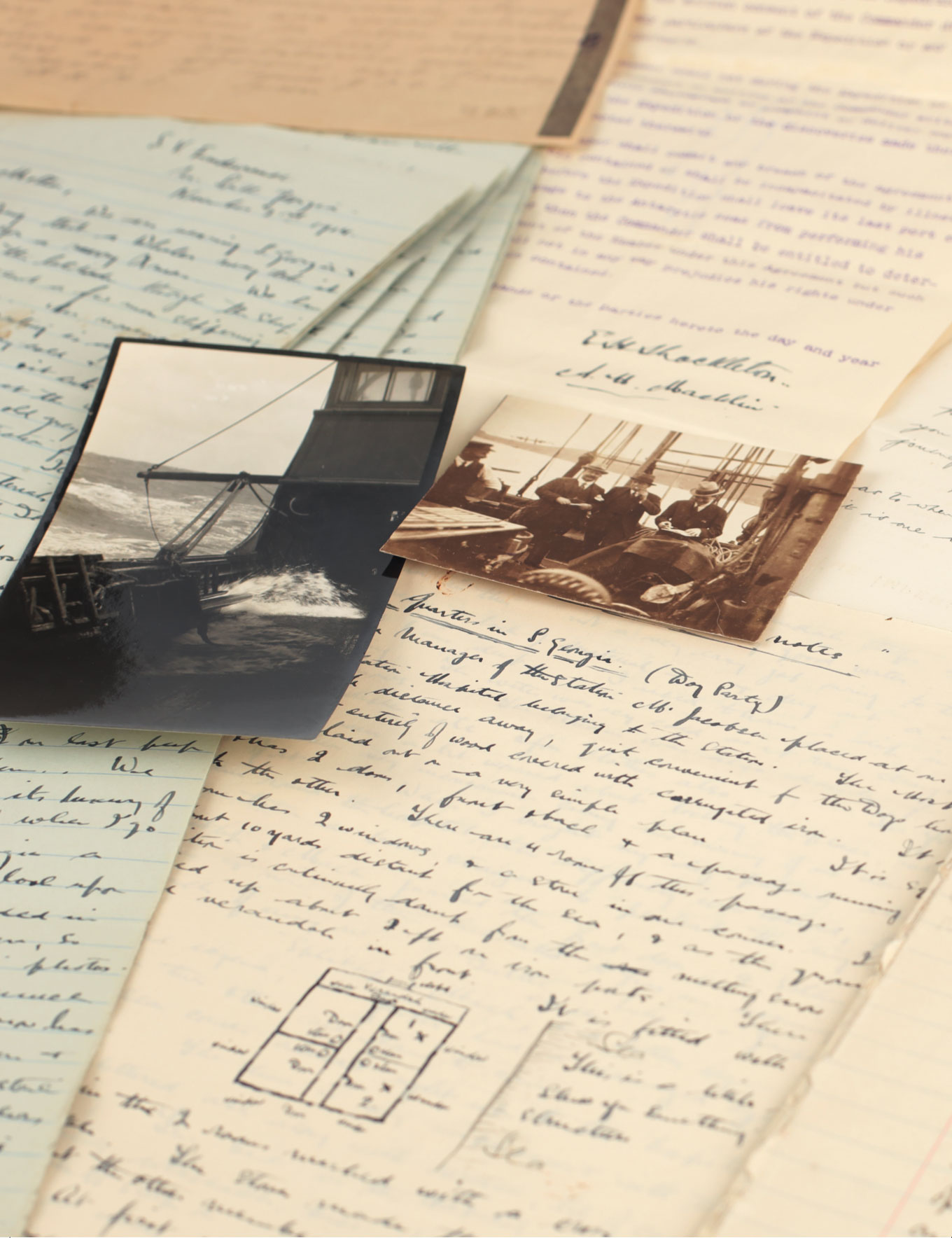
The extraordinary archive of Ernest Shackleton’s surgeon, Alexander Macklin for the three expeditions (including the Endurance 1914-16 and the Shackleton-Rowlett of 1921-22) he accompanied Shackleton on. It includes correspondence between Shackleton and Macklin aswell as the contracts between the two and the unpublished manuscript of Macklin’s account ofthe Endurance expedition.
Offered by Jonkers Rare Books (booth B17).
NOTICIA DE CALIFORNIA Y DE SU CONQUESTA TEMPORAL, Y ESPIRITUAL ��

First edition. Three volumes. Small 4tos. (24),240; (8),564; (8),436. First issue with p. II, 479 misnumbered 476. Contemporary vellum, yap edges, manuscript titles on the spines. Four folding copperplate maps: Vol. 1 contains the Mapa de la California, y su Costa Oriental Nuevamente Descubierta, based on Padre Kino's revolutionary map. Vol. 3 contains three maps: Seno de California; Carta de la Mar del Sur; and Mapa de la America Septentl. etc. The first map has a professional, nearly invisible, repair of a closed separation across the upper third of the image, no loss. Map number 4 has a neat nearly invisible repair of a closed marginal tear, no loss. Scattered light foxing; small marginal paper flaw on II, 449/450, not affecting the text; stamps of the Museo of Teneriffe on the second leaf of II, the third leaf of III, and a paper repair on the second leaf of III suggesting there was once a stamp there. No text is affected, Remains of string ties. Inner hinges of I and II expertly repaired. An altogether superior copy of this set, called by Cowan the"foundation of a library of Californiana." Venegas' manuscript was written between 1734 and 1739. It went unpublished because the Spanish Crown did not want details of New Spain disseminated. But eventually another Jesuit, Padre Burriel, edited the manuscript and saw it published. The large map in volume 1 is based on Kino's 1702 map. It is indeed revolutionary as it was the first attempt to end the notion that California was an island. Padre Consag confirmed Kino's findings in a 1746 expedition to the mouth of the Colorado. As Tooley notes (p. 111), Kino's map was not generally accepted; it was not until Consag confirmed Kino's discovery that caused Ferdinand VII in 1747 to issue a royal decree: California is not an island.
Offered by Thorn Books (booth A38).
SCOT, REGINALD. The discoverie of witchcraft, Wherein the lewde dealings of witches and witchmongers is notablie detected...
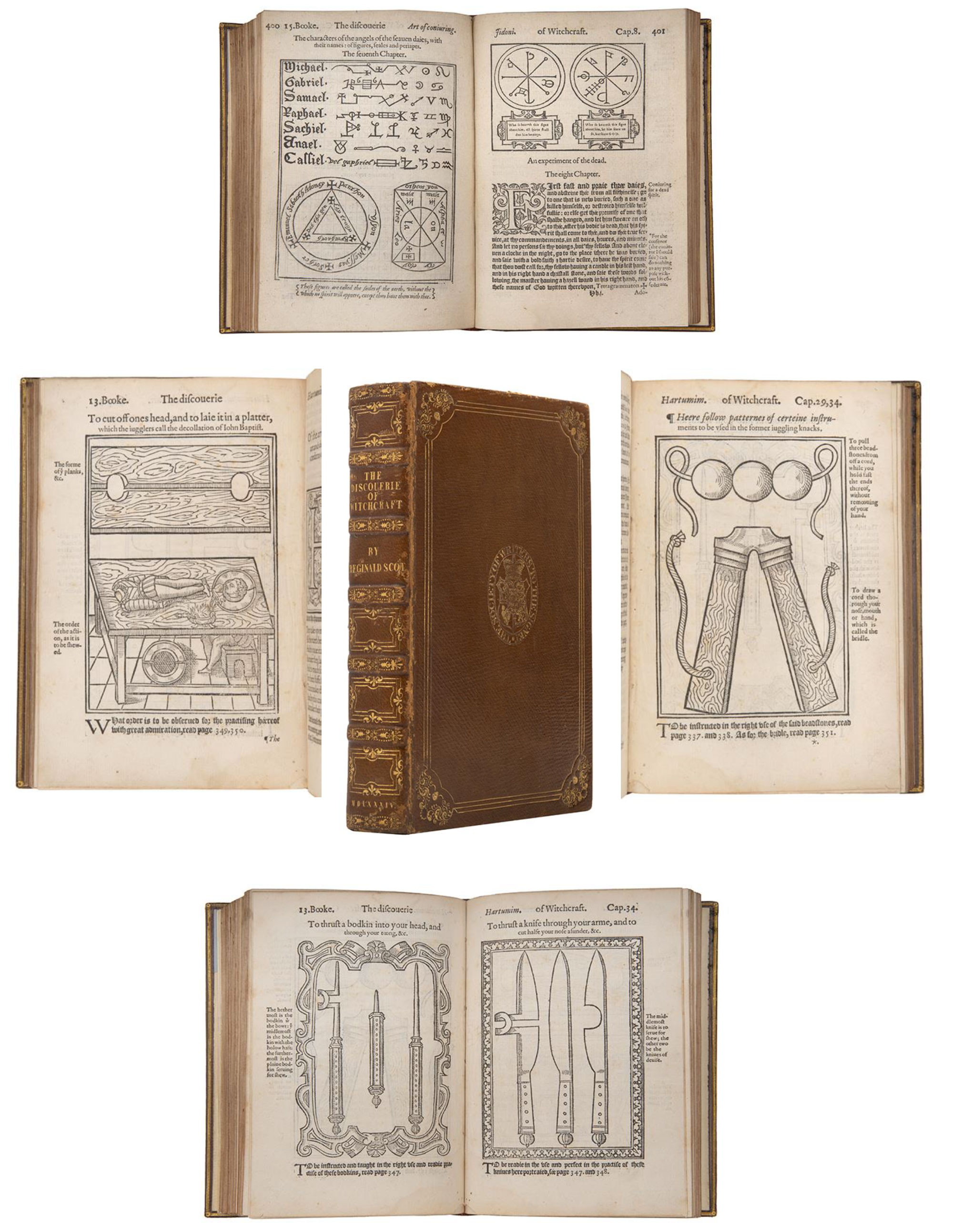
London, [Henry Denham for] William Brome, 1584. FIRST EDITION OF A REMARKABLE 16TH -CENTURY TREATISE DEBUNKING THE EXISTENCE OF WITCHES. In this explosive treatise, Scot lists 212 authors of Latin works and 23 authors in English who have informed his attack on ‘witchmongers’ who seek ‘to pursue the poore, to accuse the simple, and to kill the innocent’. He explains the phenomena as ‘resulting out of a particular type of social encounter: old women begging for food or other assistance would curse their neighbours when they were turned away empty handed; if something bad then happened — the death of a child, perhaps — the old woman would be taken to be a witch. Witchcraft accusations in England thus arose in the context of disagreements over expectations and obligations relating to charitable giving. This sociological account was persuasive to contemporaries and has been adopted by modern historians. As far as Scot was concerned, those who confessed to being witches were either deluded or the victims of torture, while much of what Bodin had taken to be evidence for the existence of witchcraft in different eras and diverse cultures, Scot was prepared to dismiss as mere fable and fiction’ (ODNB).
The keystone of a conjuring collection, Scot's Discoverie was the first work in English to reveal tricks of the conjuror's trade. He attributes manifestations of witchcraft to imposture and trickery, as demonstrated in books 13 and 14, which are largely an exposé of conjuring tricks, magical illusions and various cozening devices. According to Norman, Scot’s views had some positive effect, yet many responded in vigourous defence of the old beliefs. Among Scot’s detractors was James VI of Scotland (later James I of England), who described Scot’s opinions as ‘damnable’ and ordered the text to be burned upon his accession to the English throne. Despite the king's order to destroy all copies of this work, it survived and was frequently reprinted.
Provenance: Society of Writers to the Signet (arms to binding).
First edition; 4to (19.5 x 13.3 cm); black letter, with some Roman and italic, woodcut headpiece to title, woodcut illustrations, including 4 full-page on *1-2, large woodcut floral and historiated initials and other ornaments, title washed and repaired at head with some loss to ornament, some marginal repairs (not affecting text), minor worming to margins, repaired tears to E3 and H2-3 without loss, lightly washed; early-19th-century brown crushed morocco, arms gilt-stamped to covers within panel triple-ruled in gilt with corner flourishes, spine gilt with 5 raised bands, inner dentelles gilt, all edges gilt, slightly rubbed; [28], 352, [4], 353-360, [16]pp; collation: A8 B6 C-V8 Aa-Dd8 *2 Ee-Ss8. Bartlett 230; Graesse p58; Norman 1915; STC (2nd ed.) 21864; ESTC S116888.
Offered by Shapero Rare Books (booth E5).
ROWLING, J.K. Harry Potter and the Philosopher’s Stone.
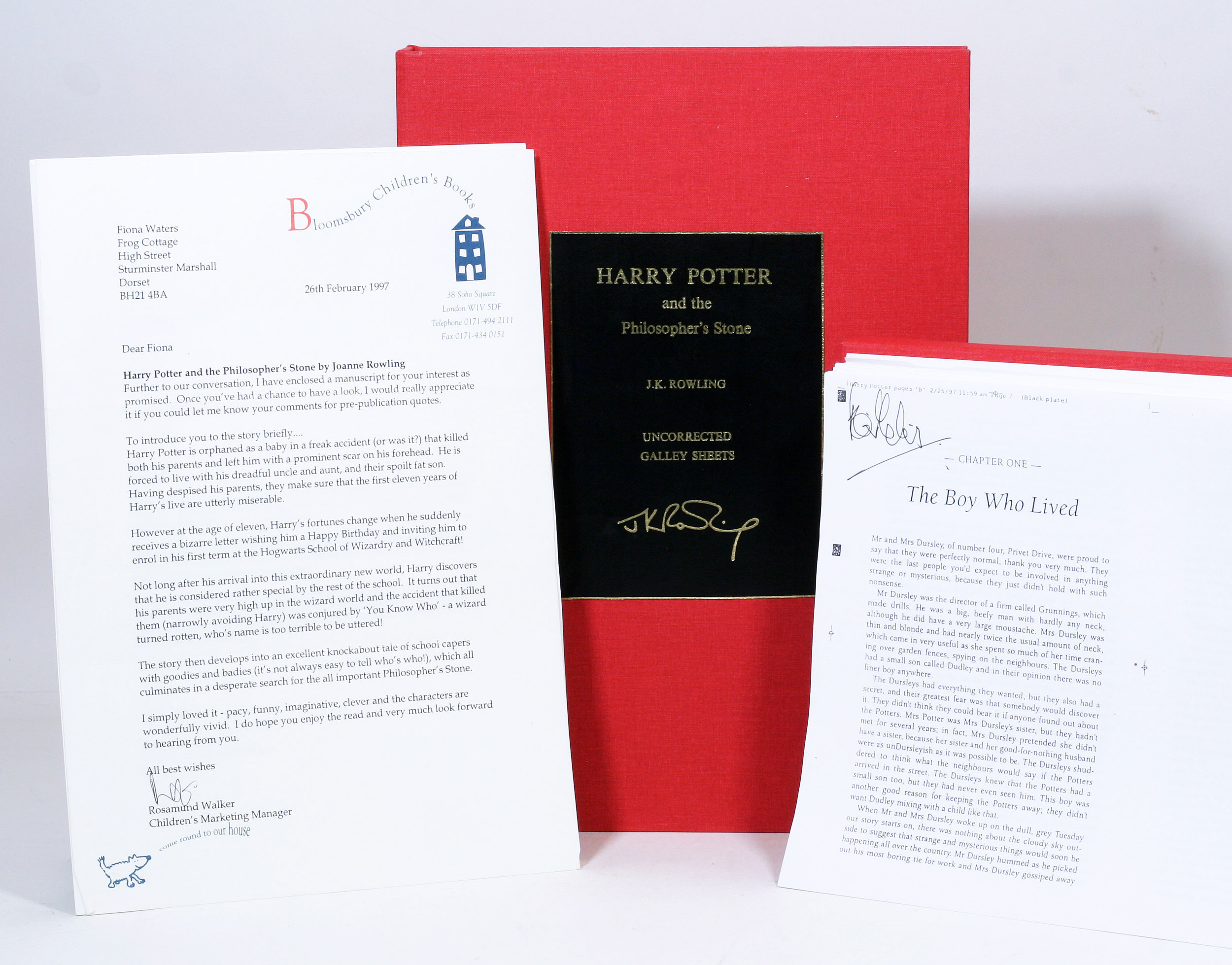
“I have just returned from my great train journey to Scotland so Harry Potter has been read! I just loved the book, it is full of pace and interest and so very funny… There is something about Harry Potter that reminds me of Charlie Buckett in Charlie and the Chocolate Factory, the put upon nice guy making good… And please may I have a finished copy, I would like to tell lots of people about it.” – Fiona Waters, to Bloomsbury Children’s Marketing Manager Rosamund Walker, 28 March 1997
EARLIEST KNOWN COPY OF HARRY POTTER; NO OTHER COPIES LOCATED.
On February 26, 1997, this remarkable complete set of galley sheets was sent to the distinguished children's author and literary critic Fiona Waters. In the cover letter accompanying the galley (included here), Rosamund Walker, Children’s Marketing Manager of Bloomsbury Publishing wrote, “Further to our conversation, I have enclosed a manuscript for your interest as promised. Once you've had a chance to have a look, I would really appreciate it if you could let me know your comments for pre-publication quotes.” The "manuscript," already rejected by twelve other publishers, was Harry Potter and the Philosopher’s Stone.
Waters read these advance galley sheets during a long train journey to Scotland and was immediately captivated by the tale of a young wizard named Harry Potter. While it was Ms. Waters’ usual practice to discard galleys after reading them, she retained this one because she believed Harry Potter was a truly special and distinctive book. She wrote back to Bloomsbury Publishing with effusive praise, making a special point of noting that “There is something about Harry Potter that reminds me of Charlie Bucket in Charlie and the Chocolate Factory.” In replying to Waters’ letter, Rosamund Walker wrote that “I’m sure the author will be most flattered with the allusion to Charlie Bucket” — and indeed she was: for the statement was featured prominently on the back cover of the first edition.
Historically significant, this is the only known set of advance galley sheets to have survived. It precedes the early June publication of some 200 bound proof copies as well as the first edition that famously appeared on June 26. Intended as they were for prominent reviewers, only a handful of such galleys were produced. Our copy belonged to a lead reviewer whose endorsement undoubtedly helped make the book the spectacular success it became. As Ms. Waters (who signed this galley on the first page) tells it, in recalling her first meeting with J. K. Rowling:
“It was very shortly after the first book was published and I was invited to a party by Bloomsbury to celebrate it all. And when I was introduced to her [J. K. Rowling], she flung her arms around me and said, Oh, you are the lovely lady who gave me that wonderful review!”
Note: By the late 1990s – well into the digital age of printing – publishers generally did not issue traditional galleys printed from a printing press, but rather printed a set of sheets from a file and copied them for distribution to a limited set of reviewers. This is such a copy; any earlier printed appearance has not been discovered and is almost certainly lost to history.
ROWLING, J.K. Harry Potter and the Philosopher’s Stone. London: Bloomsbury, February 25, 1997. Galley sheets: 224 numbered pages on 109 sheets [the complete text]. Each sheet with text in landscape format, two pages per sheet (rectos only), time-stamped: 2/25/97 11:59am to 2/25/97 12:16pm. Signed at top in ink by Fiona Waters. WITH: Original signed letter dated 26th February, 1997 from Rosamund Walker introducing the book to Waters; and original signed letter from Walker dated 1 April 1997 thanking Waters for her praise of the book. With Fiona Waters’ copy of her letter to Rosamund Walker comparing Harry Potter to Charlie Bucket. Only minor blemishes, generally fine condition. Housed together in a custom box.
The earliest known copy of Harry Potter ever offered for sale.
Offered by The Manhattan Rare Book Company (booth E28).
Rowling, J. K. Harry Potter and the Philosopher's Stone.

London: Bloomsbury, 1997. First edition, first printing (number line 10 to 1). One of only 500 copies. Publisher's pictorial boards illustrated by Thomas Taylor, with yellow, black, and white lettering, young wizard to rear panel. About near fine book with some light wear to the spine ends and the corners, light scattered bubbling to the coating of the rear panel and spine, and very slight lean to the spine. An excellent copy of the exceptionally scarce true first British edition of the first Harry Potter novel.
First published in 1997, Harry Potter and the Philosopher's Stone is the first book in the Harry Potter heptalogy. It introduces both Harry and readers alike to the secret, magical world of witches and wizards in Great Britain. It also sets the stage for the six subsequent novels by familiarizing readers with the villainous Lord Voldemort and how his and Harry's fates are inevitably intertwined. Although often regarded as a children's novel, Harry Potter and the Philosopher's Stone topped adult reading charts in the UK, and in the United States where it was published under the alternate title Harry Potter and the Sorcerer's Stone. Notably, the first printing of this book in hardcover format is exceedingly rare; only 500 copies were printed, of which about 300 ended up in libraries. Despite its small print run, the book was an immediate success, and went through dozens of print runs within the first few years after publication.
Offered by B&B Rare Books (booth B6).
Jung, Wilhelm. Catalog of Manuscript Jewellery Designs.
.jpg)
No place (Germany), 2. August 1905-28.Januar 1907. 198 numb. leaves (recte 200 ; leaf 137 numbered twice and one unnumb. leaf) with hundreds of original designs in pen, pen-and-ink and wash colours of a wide range of jewellery on rectos, but including a certain number of designs on versos also. Each leaf with manuscript date on verso with indication of day, month and year. 6 leaves lacking (nos. 78 ; 114 ; 128 ; 155 ;156 ; 174), 1 leaf torn in half. Cont. black half calf over cloth boards, manuscript paper label to front cover titled " Wilhelm Jung–angefangen 2. August 1905–28. Januar 1907). Endpapers lined with fancy paper. Oblong folio (340 x 260 mm). Label chipped, spine rubbed.
A fascinating manuscript catalogue by a German jewellery designer with an almost unbelievable variety of pieces of jewellery of all sorts including rings and earrings, pins and brooches, necklaces with pearls and with pendants, bracelets, cuff links, seals, ribbons, tiaras and barrettes. The majority of designs handcoloured with added wash colours, quite a number of them with manuscript numbers, some crossed out, etc. Minor thumbing and traces of usage, a wonderful catalogue, showing the intense efforts of a jewelllery designer over a period of two years to delineate a wide variety of jewellery designs on behalf of a German jewellery manufacturer.
Offered by Antiquariat Banzhaf (booth B19).
(In Hebrew). K'TINA KOL-BO by Chaim Nachman Bialik 1873-1934)

Illus. with color and b/w lithographs by A. Bihem and Rachel Shalit - Marcus. Dr. Selle & Co. Copyright 1923: Rimon-Verlag, Berlin. In the Original publishers soft-bound cover Chaim Nachan Bialik was a Jewish poet and is recognized as Israel's National Poet. RARE.
Offered by Enchanted Books. (Update: Enchanted Books are no longer attending the New York Book Fair. If you are interested in this item, contact Enchanted Books directly.)
UNIQUE 1866 LINCOLN MOURNING FAN
A Unique Variant Produced for Display At the World’s Fair of 1867 in Paris
.jpg)
OPEN-WORK, EMBOSSED ALUMINUM COMMEMORATIVE FAN: TWO SIDED, 3-INCH, PAINTED LITHOGRAPHIC PAPER FAN-LEAF. Designed By August E. A. Luce for Bartolomé Crespo De Borbon, Habana-Paris, 1866. Original ornate tassel still attached. 22 x 10 in. wide when open. Presented in a special leather exhibition case, 8-1/4 x 12 inches, 1-1/4 inches high.
BELOW THE HAND-COLORED, PAPER FAN-LEAF there are small oval areas for albumen photographs to be attached on both sides. There were three distinct markets for the fan: North America, Spain and France (and perhaps China); and Central America. The one for North America had photos of Civil War Union generals and politician and that for Europe and Asian had various Queens of Europe (named Belgium, Spain, China, etc.). This fan was of the European type, unusually still retaining most of its albumen photographs (the glue didn’t always hold and this is the most we’ve seen still attached).
WE HAVE HANDLED ALL THREE OF THOSE PREVIOUSLY ON THE MARKET, each one a bit different. One had wooden sticks. Another, produced for women’s defense, had a hidden, retractable knife blade and a small, hinged receptacle for poison; this for Central America. The third with Union generals’ portraits for the US market; different in having wood instead of aluminum.
NOW, THIS ONE FOR PRESENTATION AT THE WORLD’S FAIR.
THE PRESENT FAN IS UNIQUE, being housed in a presentation red leather box titled “EX POSITION UNIVERSELLE DE PARIS 1867”. On the inside is a felt receptacle for the partially closed fan and the words “EVENTAIL BLINDE [armored fan] ROYAL”. Obviously, this was specially produced for display at that fair. The fan was listed in the Fair catalog (not present), Catalogo general de la seccion de Espana, under the Overseas submissions from Cuba (page 408: Abanicos blindados [armor-plated fan], con reproducciones fotograficas de las principals fases de la vida del Presidente Lincoln y do los garndes hombres Americnos sus contemporaneos.”
THIS FAN IS ALSO SINGULAR in that the blades and sticks are of a very sparkly, silver nature, embellished with unique decorative ornamentations.
THE GUARDS AND 9 STICKS are of cast aluminum, a product then considered a precious metal. The sticks are enhanced with medallions supported by American eagles, terminating in the form of a star. The guards also have special imprinted designs
THE PAPER RECTO has a painted portrait of Lincoln, surrounded by angels and cherubs, two columns topped by American eagles, and photo reproductions of a Spanish song w/ music; THE VERSO has 5 scenes of the assassination events, each surrounded by demon images; reproductions of battle scenes are included. WORTH NOTING: the eagles on the recto hold banners inscribed “The patent plated fan” (the Cuban maker had bought the rights from an American firm).
Lincolniana offers one of the richest areas of collecting, because of the numerous intersects that occur throughout the Lincoln story. This fan embodies a number of those intersects: Historical Memory; Victorian Artistic Tastes; Technology (the aluminum); and Mourning Culture.
As a Victorian mourning item, this is one of the loveliest display pieces found. In character, composition, and technique, the lithographs on both sides convey not even the faintest suggestion of European taste; but are, indeed, distinctively American and could almost have emerged from the presses of Currier and Ives. There is a long tradition of producing women's fans with American presidents or patriotic themes as subject matter, beginning with a French-made fan celebrating Thomas Jefferson's 1801 Inauguration. In terms of its elaborate construction, beautiful and detailed vignettes, and superb condition, this is surely the finest example of this genre which we have encountered.
Offered by Abraham Lincoln Book Shop (booth B25).
A Beautiful First Edition Copy of the Book that Proclaimed the Dawn of Modern Feminism
Le Deuxième Sexe (The Second Sex).

Gallimard, Paris, 1949. Volume 1: 1 blank leaf + half title with a list of her works on the verso + TP + [7] = Dedication page + half title + [11]-395 + [397] = half title + [399] = Index + [400] = Printing Information; Volume 2:1 blank leaf + half title with a list of her works on the verso + TP + [5] = Quote page + [7] = Introduction + half title + [13]-577 + [579] = half title + [581] = Index + [583] = Printing Information, Octavo. First Edition.
One of 2,000 numbered copies (from an edition of 2,150) on alfama Marais paper. Originally published, printed and numbered months apart (April 20th and September 14th) – hence, Volume 1 is numbered 1180 and Volume 2 is numbered 841.
Beauvoir's landmark work on feminism appeared at a crucial turning point immediately following the Second World War, wherein she offered a profound and scathing analysis of patriarchal society and what it means to be a liberated woman in the West. One of her most important pieces of writing, The Second Sex was translated into over a dozen languages and played a pivotal role in the transition from the ‘old feminism’ of the woman suffrage movements to the ‘new feminism’ (the so-called “second wave”) that has dominated gender politics ever since – setting the agenda for women's rights throughout the nineteen fifties and well beyond.
“...if nevertheless we admit, provisionally, that women do exist, then we must face the question “what is a woman?”
To state the question is, to me, to suggest, at once, a preliminary answer. The fact that I ask it is in itself significant. A man would never set out to write a book on the peculiar situation of the human male. But if I wish to define myself, I must first of all say: ‘I am a woman’; on this truth must be based all further discussion. A man never begins by presenting himself as an individual of a certain sex; it goes without saying that he is a man... In actuality the relation of the two sexes is not quite like that of two electrical poles, for man represents both the positive and the neutral, as is indicated by the common use of man to designate human beings in general; whereas woman represents only the negative, defined by limiting criteria, without reciprocity. In the midst of an abstract discussion it is vexing to hear a man say: ‘You think thus and so because you are a woman’; but I know that my only defense is to reply: ‘I think thus and so because it is true,’ thereby removing my subjective self from the argument. It would be out of the question to reply: ‘And you think the contrary because you are a man’, for it is understood that the fact of being a man is no peculiarity. A man is in the right in being a man; it is the woman who is in the wrong. It amounts to this: just as for the ancients there was an absolute vertical with reference to which the oblique was defined, so there is an absolute human type, the masculine. Woman has ovaries, a uterus: these peculiarities imprison her in her subjectivity, circumscribe her within the limits of her own nature. It is often said that she thinks with her glands. Man superbly ignores the fact that his anatomy also includes glands, such as the testicles, and that they secrete hormones. He thinks of his body as a direct and normal connection with the world, which he believes he apprehends objectively, whereas he regards the body of woman as a hindrance, a prison, weighed down by everything peculiar to it... Thus humanity is male and man defines woman not in herself but as relative to him; she is not regarded as an autonomous being.”
Bound in the publisher's original cloth with the colorful, modern design supplied by Mario Prassinos. A well-preserved, near fine copy of an extremely important and influential work in the history of ideas from the mid-20th century.
Offered by Athena Rare Books (booth E20).
Outstandingly Beautiful!
(PERFUME.) A perfume sample album from the Piver perfume house. Paris, c.1820-1870.

Oblong: 21.5cm x 29cm. [29] leaves of artwork mounted on rectos only. Contem- porary dark purple morocco, ornately gilt and blind stamped, with red, green and yellow inlay, spine gilt and blind-stamped in five compartments, edges gilt, white papier moiré endpapers, gilt dentelles.
This is the most exceptional perfume album we have ever seen. Approximately 220 different printed and hand-painted labels for perfume and various cosmetics are included, most of which are richly ornate and presented on hand-painted lithographed images of perfume bottles as well as various boxes, tubes, and little packages. In addition to perfume and cologne, we find products such as oils, scents, waters, aromatic vinegars, soaps, bouquets, essences, extracts, creams, powders, ointments,
and various health products. In terms of printing techniques, there are engraved labels, lithographed labels, labels printed in color, and those embossed in gilt and various bright colors. The condition is very fine and all samples are well preserved.
Offered by Ben Kinmont Bookseller (booth C3).
(Jeweled Binding).
GUINEVERE: A POEM BY ALFRED, LORD TENNYSON.
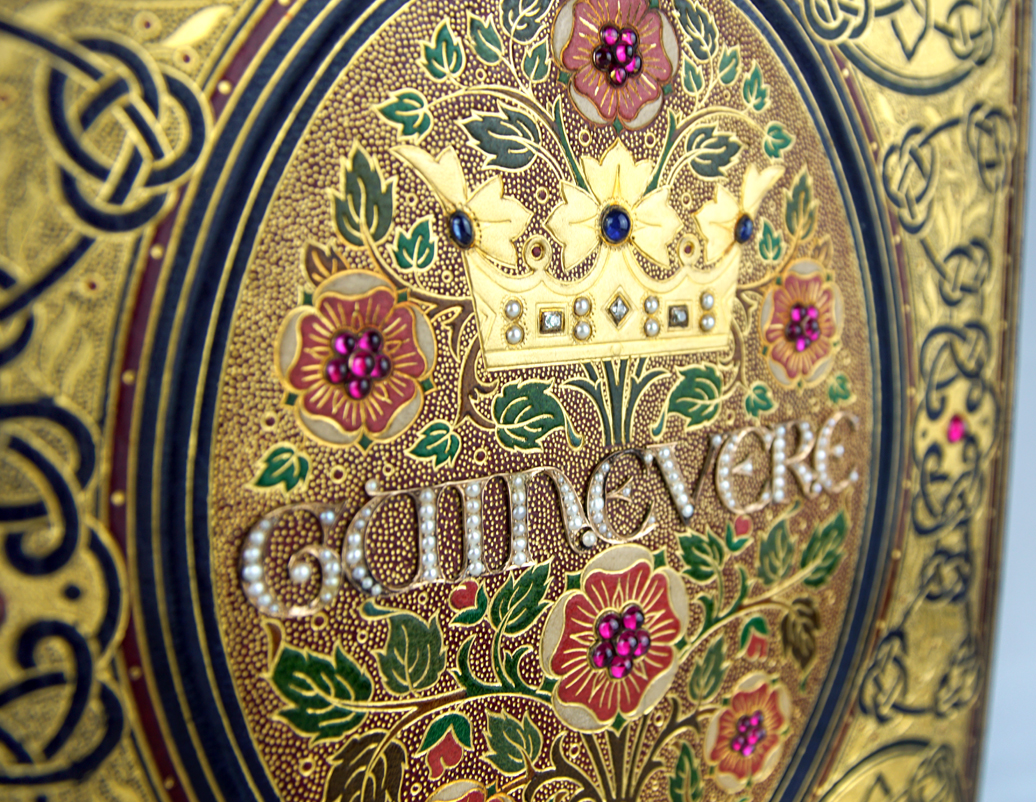
London, 1913. Quarto. 34ff., + 3ff. at both front and back. Signed by Alberto Sangorski. A unique manuscript on vellum, designed, illuminated, and hand-lettered by Sangorski. A triumph of early twentieth-century British book craftsmanship and artistry, this seminal work boasts a robust, complete artistic vision. Begun in or around 1912 (according to the frontispiece portrait of Guinevere, which Sangorski dates along with his "AS" monogram), the manuscript perhaps represents Sangorski's response to his brother Francis's extravagantly jeweled Rubaiyat, which sank with the Titanic in April of that year. Alberto Sangorski was notably dissatisfied with that production, feeling that such an elaborate binding had been wasted on a printed text. By contrast, he has here created a vibrant presentation of Tennyson's Arthurian poetry. A pictorial title page displays at center a faithful miniature portrait of the author, surrounded by cherubim, a female nude, and a bat, as well as titling in gold and floral borders. The frontispiece shows a contemplative Guinevere at Almsbury, where, after Arthur's death, she became a nun, a part of her story reflected in the dragons, coats-of-arms, and miniature of nuns at Mass rendered in the illuminated border. Then follows the poem's text calligraphed in red and black inks, on pages always illuminated and glimmering with one or more initials. Three additional full-page miniatures, also signed by Sangorski, punctuate the text, and each exhibits a similar border to that found at the frontispiece. One half-page miniature and eleven border miniatures, plus those five previously mentioned, bring the total to seventeen miniatures, all protected by cream silk guards.
Bound by Rivière & Son with a level of decoration that may be considered a high-water mark of the firm. Full crushed blue morocco is heavily jeweled and decorated in gilt. The upper cover is dominated by a sunken oval panel edged in red morocco, enclosing the title "Guinevere" lettered in seed pearls set in gold, with the background of a rose bush in three shades of green morocco, branches in brown, and six Tudor roses in cream and pink, each with six rubies set in gold. Above the title is a gold plaquette shaped as a crown set with diamonds, seed pearls, and three sapphires. Around the oval is an intricate strapwork design of gilt rules and gilt-stamped vines with red inlaid morocco berries and a remarkable amount of gilt pointillé. All four corners with matching designs incorporating four amethysts and one garnet each, and the four sides each bear a ruby. The lower cover surround—strapwork, pointillé, sixteen amethysts, four garnets, six rubies—matches the upper, as does the central oval border. Within the oval is the crest of King Arthur: the mantling and helmet are silver plaquettes ruled in black; plumes likewise, with blue morocco ruled in gilt; crown, dragon, and motto, "Soli Deo Gloria," as gold plaquettes finely tooled. Eleven rubies surround the crown, which is further emblazoned with three rubies. Spine gilt in six compartments with raised and gilt bands, each compartment with inlaid red morocco borders with gilt rules; two compartments with gilt titling, remaining four with gilt-backed strapwork. Board edges with double rule in gilt. Inner doublures identical, with lush pointillé and extensive strapwork set on brown morocco, with an oval of blue and acanthus leaves of green, blue, and brown morocco. Faced by flyleaves of red morocco with green borders and a frame of strapwork, gilt pointillé, and navy morocco inlaid lozenges and dots. A.e.g. Housed in a silk-lined dropback box.
Offered by Bromer Booksellers (booth D10).
The Left Hand of Darkness by Ursula K. Le Guin
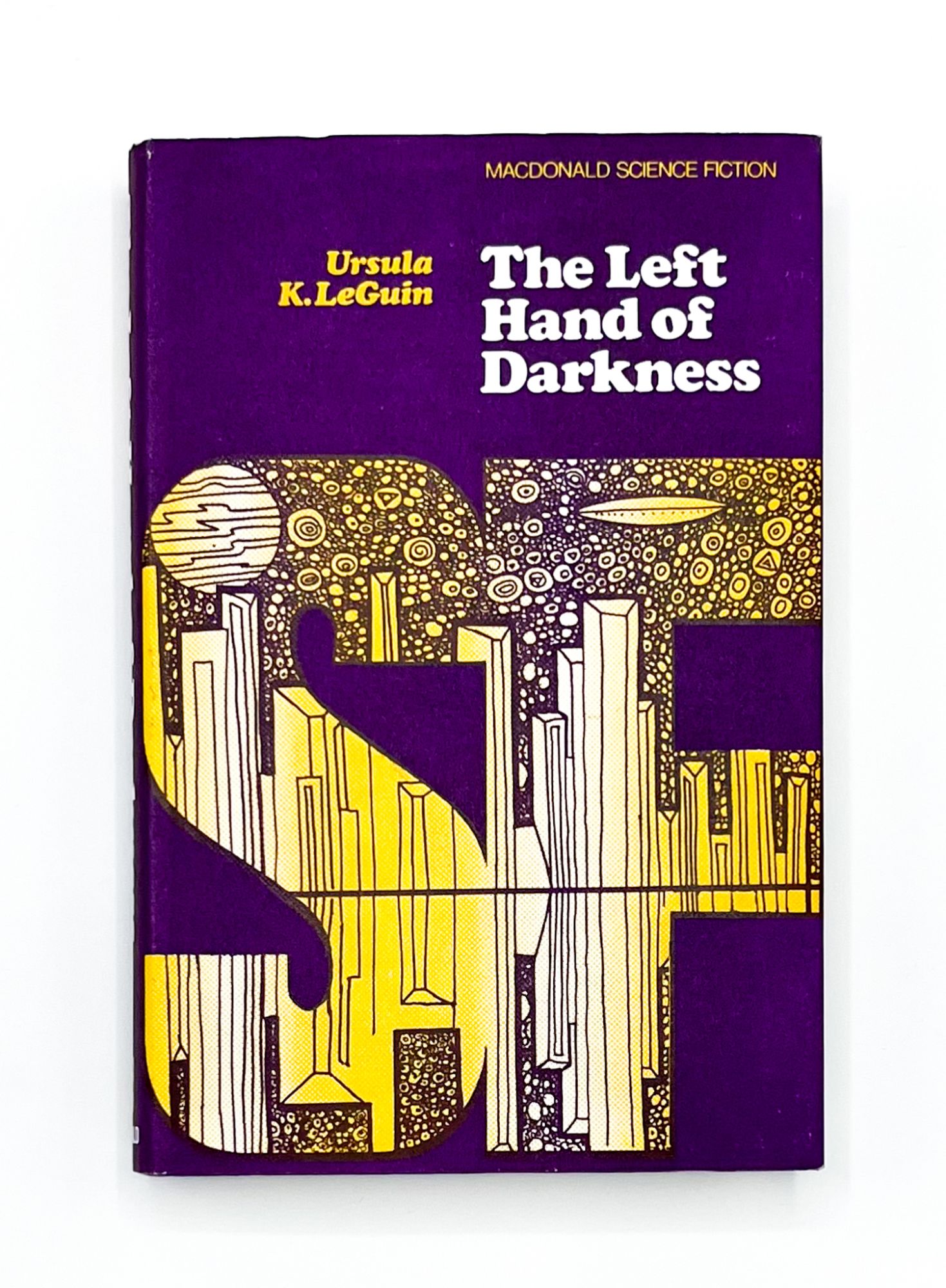
(1969): Signed first UK edition of the famous radical science fiction novel on gender and isolation, by one of the most influential writers in the genre -- a stunning copy.
Offered by Type Punch Matrix (booth A19).
ROCKWELL, Norman. A SUITE OF FIFTEEN COLOR PRINTS OF SATURDAY EVENING POST COVERS.
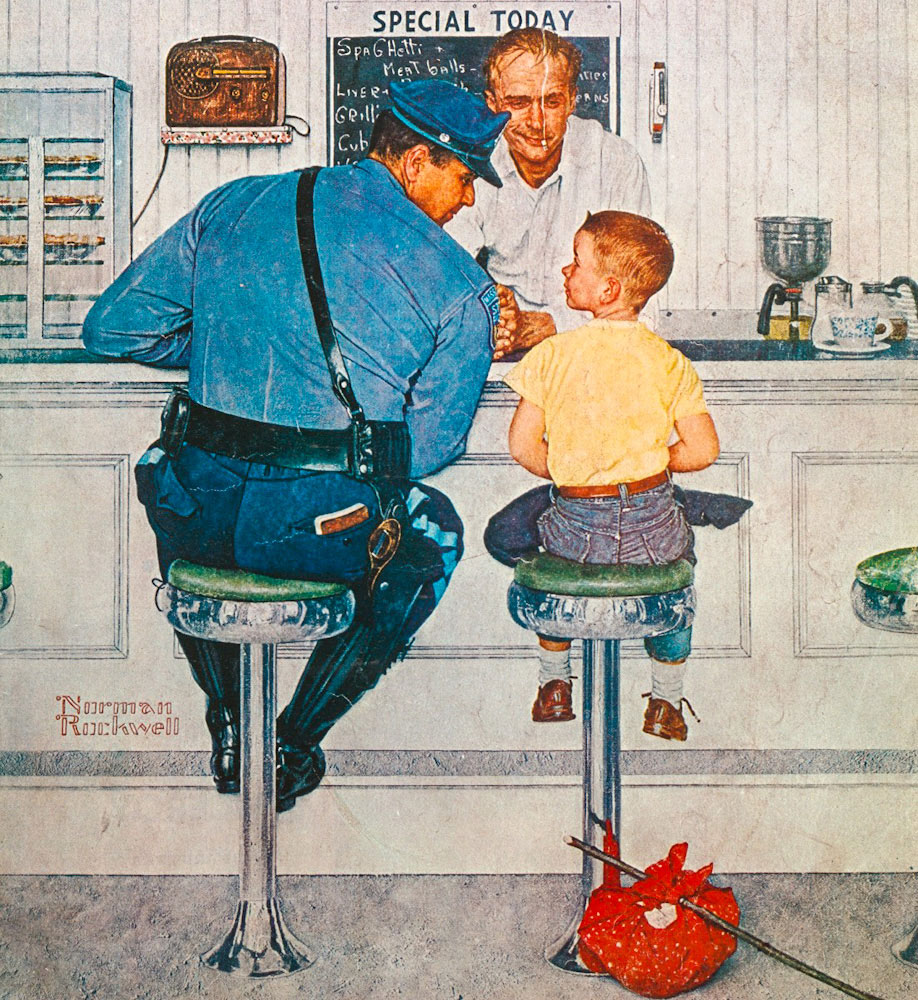
Philadelphia: Harry N. Abrams, (1972). First Edition. Portfolio with loose sheets (approximately 19" x 25") laid in, as issued. Sheets include title page, contents page, two pages of text by Thomas S. Beuchner, and 15 color prints by Norman Rockwell. A superb collection of archetypal Rockwell images, including many of his best known images, gathered here in a deluxe presentation. Although not called for, each print is SIGNED by the illustrator at the lower right margin. The prints included are "The Runaway," "The Truth About Santa," "The Art Critic," "Shuffelton's Barber Shop," "Homecoming," "Tired But Happy", "No Swimming," "Family Tree," "Only Skin Deep," "Weighing In," "Tough Call," "Walking to Church," "Marriage License," "Roadblock," and "Before and After." Seldom found complete, let alone with each print SIGNED, as here. Small tear to margin of title page; all prints are Fine. Fine in a Near Fine wood-patterned printed board portfolio with a cloth backstrip and a metal clasp device, all contained in the original mailing carton.
Offered by Charles Agvent (booth E29).
Kien, Peter (Notes designed by). Complete Currency Set in Use at the Concentration Camp of Theresienstadt (1, 2, 5, 10, 20, 50 and 100 Kronen).
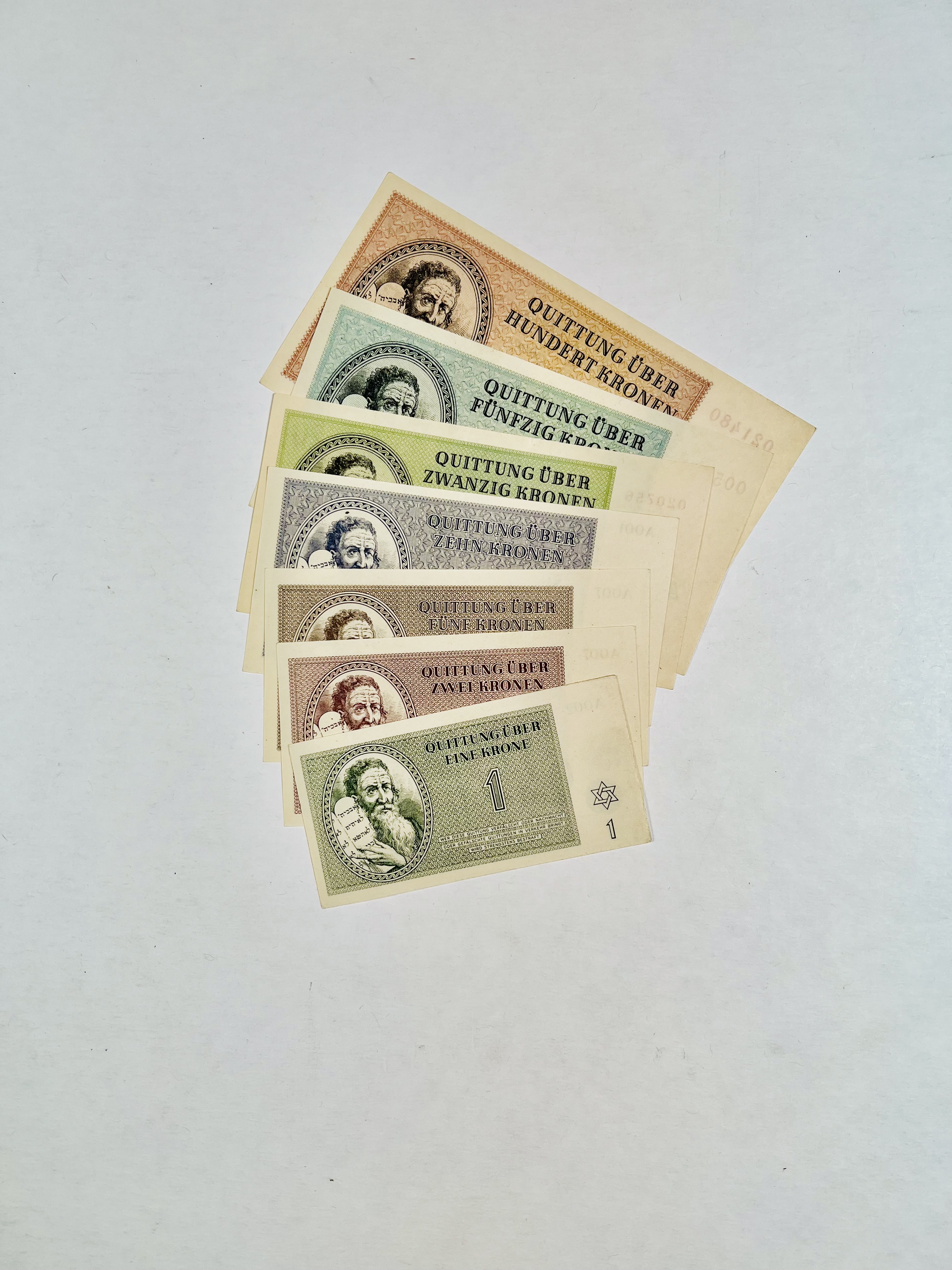
Theresienstadt: Der Alteste der Juden, 1943. Original documents.
This complete seven-piece currency set from the notorious Theresienstadt camp sheds light on the elaborate sham by the Nazi propaganda machine to present Terezin as a "model camp."
Even though no normal trade and business activities were possible in concentration camps, it was not uncommon to see local notes and tokens. As soon as deportees arrived they had to exchange all their money, bonds and shares into “local currency.”
At the camp of Theresienstadt located North of Prague and in the old stronghold of Terezin, the notes were divided into the following seven denominations: 1, 2, 5, 10, 20, 50 and 100 Kronen - the Krone being the currency of Bohemia and Moravia. All those different values had the same design, but differed in size and color.*
The notes were designed in 1942 by Czech artist, poet and inmate Peter Kien** who died in Auschwitz in 1944. The primary design was a vignette of Moses holding the Ten Commandments and it was approved in the first instance by Jacob Edelstein, the Chief of Theresienstadt’s Council of Elders. His original design of Moses’ portrait was approved by the Council of Jewish Elders and the camp commandant but not by Adolf Eichmann, head of the Gestapo Department for Jewish Affairs. He considered Moses too Aryan in appearance and ordered that he should be portrayed with a prominent hooked nose and curly hair. Eichmann also required that Moses’ hand obscure the commandment “Thou shalt not kill,” and that the denominations be changed from “Ghetto Kronen” to just “Kronen.”
The front of the notes has a vignette of Moses holding the tablets of the Ten Commandments at left. In the center are the words “Quittung Über” (Receipt for), the denomination in words then the denomination in numerals and a warning against counterfeiting. At the lower right is the denomination in numerals and a six pointed Star of David. The back of the notes includes the same “Quittung über” followed by the denomination. The place and date at lower left and the title - the first Elder of the Jews in Theresienstadt - and signature of Jakob Edelstein are at lower right. At lower left the Star of David and denomination in figures. The upper left contains the serial number (20, 50, 100 kr) or plate letter and number (1, 2, 5, 10 kr).
The notes - our collection was not circulated - were dated 1st January 1943 but the first distribution was not made until May 12 1943.
Although a good mean to bolster the ruse of normality within Theresienstadt, the notes had no real economic value but could be used to pay certain taxes, amongst others those on packages entering the camps (above the taxes already paid by the sender). Camp shops were only shop windows and, ironically, those windows were mostly filled with objects seized from the Jews at their arrival in the ghettos.
Life in the ghetto had little in common with the note’s lavish design. Almost all inmates perished or were transported to Auschwitz. More than 140.000 Jews have been transported to Theresienstadt. At the time of its liberation on May 8, 1945 only a little more than 17,000 starving and terrorized inmates were found. Near fine condition. currency notes.
* 1 Kronen (green): Number printed: 2,242,000; Size: 3 7/8 x 2" (98 x 49mm); Series letters: A & plate number
2 Kronen (red): Number printed: 1,019,000; Size: 4 1/4 x 2 1/8" (107 x 53mm); Series letters: A & plate number
5 Kronen (brown): Number printed: 530,000; Size: 4 1/2 x 2 1/4" (113 x 57mm); Series letters: A & plate number
10 Kronen (blue): Number printed: 456,000; Size: 4 7/8 x 2 1/2" (124 x 62mm); Series letters: A & plate number
20 Kronen (green): Number printed: 319,000; Size: 5 1/8 x 2 5/8" (130 x 67mm); Series letters: A-R & serial number 50 Kronen (blue): Number printed: 159,000; Size: 5 1/2 x 2 3/4" (139 x 70mm); Series letters: A-H & serial number
100 Kronen (tan): Number printed: 279,000; Size: 5 3/4 x 3 1/8" (148 x 79mm); Series letters: A-O & serial number
** Peter Kien (1919-1944) was a Jewish artist and poet active at the Theresienstadt concentration camp. Between his arrival at Terezin in 1941 and his deportation to Auschwitz, Kien was officially the director of the Technical Drawing Office of the Jewish Self Administration. Using stolen paper, he rendered many sketches of living conditions in the Terezin ghetto. These works range amongst the most important ones documenting that Theresienstadt was indeed a concentration camp rather than the model Jewish settlement as it was portrayed by the Nazis in public. The drawings accurately reflect that its inhabitants were confined under inhuman conditions. On October 16, 1944, Peter Kien was deported to Auschwitz, with his parents and his wife, in the final transport. He died from disease soon after his arrival. None of the others survived. (From Wikipedia)
Offered by Eric Chaim Kline Bookseller (booth D23).
4 Vols. Thomas Ireland. History of Napoleon.
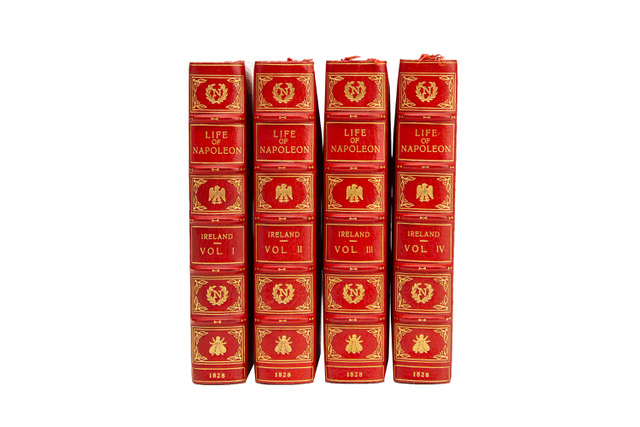
Bound In full red Morocco, Cosway Style Bindings, with hand-colored plates. First editions.
Offered by Imperial Fine Books (booth E14).
Stephenson, Neal. Snow Crash

New York: Bantam Books (1992). First edition. 8vo. [6], 440, [6] pp. Quarter blue cloth over maroon paper-covered boards with silver lettering on the spine. Price of $22.00 on the front jacket flap. First printing of the first hardcover edition. Near Fine in very near Fine dust jacket. The front board mildly bowed; the front flap of the jacket with a very faint corner wrinkle. Inscribed with personalization ("To Rory") by Neal Stephenson on the title page. Snow Crash is among the most influential science fiction novels ever written. This novel is largely responsible for popularizing the term 'avatar' to refer to a person's three-dimensional representative within a virtual environment and also coined the term 'metaverse' (referring to an immersive online virtual world) which has become ubiquitous within the world of high-tech. The novel works as both a cyberpunk novel and a satire of the genre. Bursting with ideas, creativity, humor, and the philosophical and technical musings Stephenson is so well-known for, Snow Crash is one of the finest science fiction novels ever written and remains one of Stephenson's most popular works. A sharp copy, uncommon in the first edition, reportedly due to an unusually small print run.
Offered by Evening Star Books (booth B8).
ERIC IDLE’S LIBRARY

Highlights from the private library of revered British actor Eric Idle, founding member of the Monty Python comedy troupe, will be on offer at the New York International Antiquarian Book Fair (NYIABF) by johnson rare books & archives. British history, literature, rock and roll, along with humor, comedy and musical theater are just a few of the subjects covered in Idle’s library, accumulated over the nearly three decades he lived in Los Angeles.
“I’m never happier than when reading a book. I read a lot of books. I find books endlessly inspiring,” Idle says, pointing to a shelf of British history he referenced for sketch ideas. Among the books for sale are first editions of Winston Churchill’s four volume “A History of the English-Speaking People” (1956-58) and Gilbert Abbott à Beckett’s “The Comic History of England” (1847-48).
As for the new owners of the books, Idle’s advice “Enjoy them. I think books are there to be enjoyed. Read them with pleasure and share your pleasure with other people.” The collection includes books signed by several rock musicians, who Idle counted among his friends, such as George Harrison and Ringo Starr.
Citing his first edition of F. Scott Fitzgerald’s The Great Gatsby as a favorite (and not offered for sale), Idle says he prefers to read books in their first edition because “you get a sense of history…somebody once read this for the first time at that time.”
Offered by johnson rare books & archives (booth A10).
TONY KUSHNER’S ANGELS IN AMERICA (1992) WINDOW CARD THEATRE POSTER
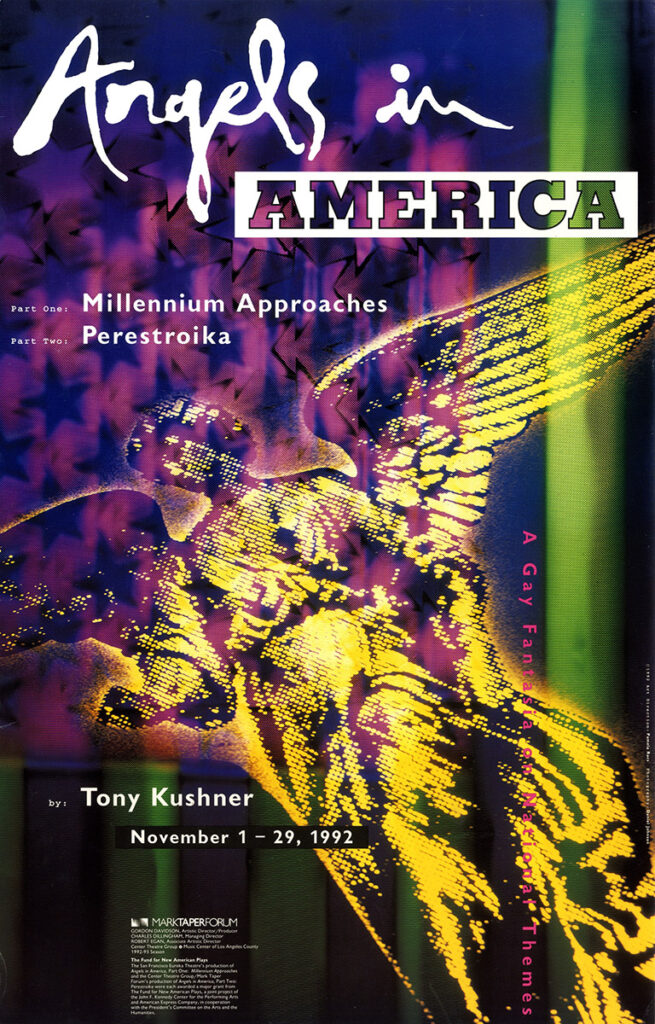
Los Angeles: Mark Taper Forum, 1992. Vintage original 22 x 14″ (56 x 36 cm.) window card theatre poster. Unfolded, with just a slight trace of creasing at extreme edge of poster, just about fine.
Tony Kushner’s epic two-part play had a complicated production history.
Angels in America was commissioned by the Eureka Theatre in San Francisco, by co-artistic directors Oskar Eustis and Tony Taccone. It was first performed in Los Angeles as a workshop in May 1990 by the Center Theatre Group at the Mark Taper Forum.
The play’s first part, Millennium Approaches, premiered in May 1991 in a production performed by the Eureka Theatre Company of San Francisco, directed by David Esbjornson. In London it premiered in a National Theatre production at the Cottesloe Theatre, directed by Declan Donnellan.
The second part, Perestroika, was still being developed as Millennium Approaches was being performed. It was performed several times as staged readings by both the Eureka Theatre (during the world premiere of Part One in 1991), and the Mark Taper Forum (in May 1992). It premiered in November 1992 in a production by the Mark Taper Forum, directed by Oskar Eustis and Tony Taccone. In November 1993 it received its London debut in a National Theatre production on the Cottesloe stage, in repertory with a revival of Millennium Approaches, again directed by Declan Donnellan.
The entire two-part play finally debuted on Broadway at the Walter Kerr Theatre in 1993, directed by George C. Wolfe, with Millennium Approaches performed on May 4 and Perestroika joining it in repertory on November 23, closing December 4, 1994.
This very scarce poster is from the play’s run in Los Angeles at the Mark Taper Forum in November 1992. This was the first time that the play was presented in its full two-part form.
Offered by Walter Reuben, Inc. (booth B22).
The Morris-Levin Collection of Publishers’ Bookbindings
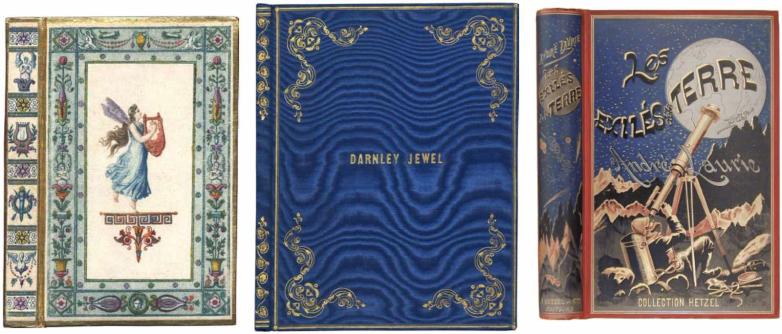
Over 50 years, Ellen Morris and Edward Levin collected more than 3,000 volumes representing the first century of commercial book design in Europe and the United States. Morris and Levin curated the historic 2000 Grolier Club exhibition The Art of Publishers’ Bookbindings, 1815-1915, and wrote the accompanying print catalogue, now a standard reference. The 254 bindings included in the Grolier exhibition were hand-picked by Morris and Levin to illustrate international developments in book production, design, and marketing, from the earliest publishers’ bindings to the dawn of the dust jacket.
At this year’s New York Antiquarian Book Fair, the 254 Morris-Levin exhibition books will be offered en bloc by Honey & Wax Booksellers and Johnson Rare Books and Archives. Both booths will display a selection of publishers’ bindings from the original Grolier show, including uncommon examples that have not appeared on the market in decades.
Offered by Honey & Wax Booksellers (booth B33) and johnson rare books & archives (booth A10).
Bemelmans, Ludwig. Madeline.
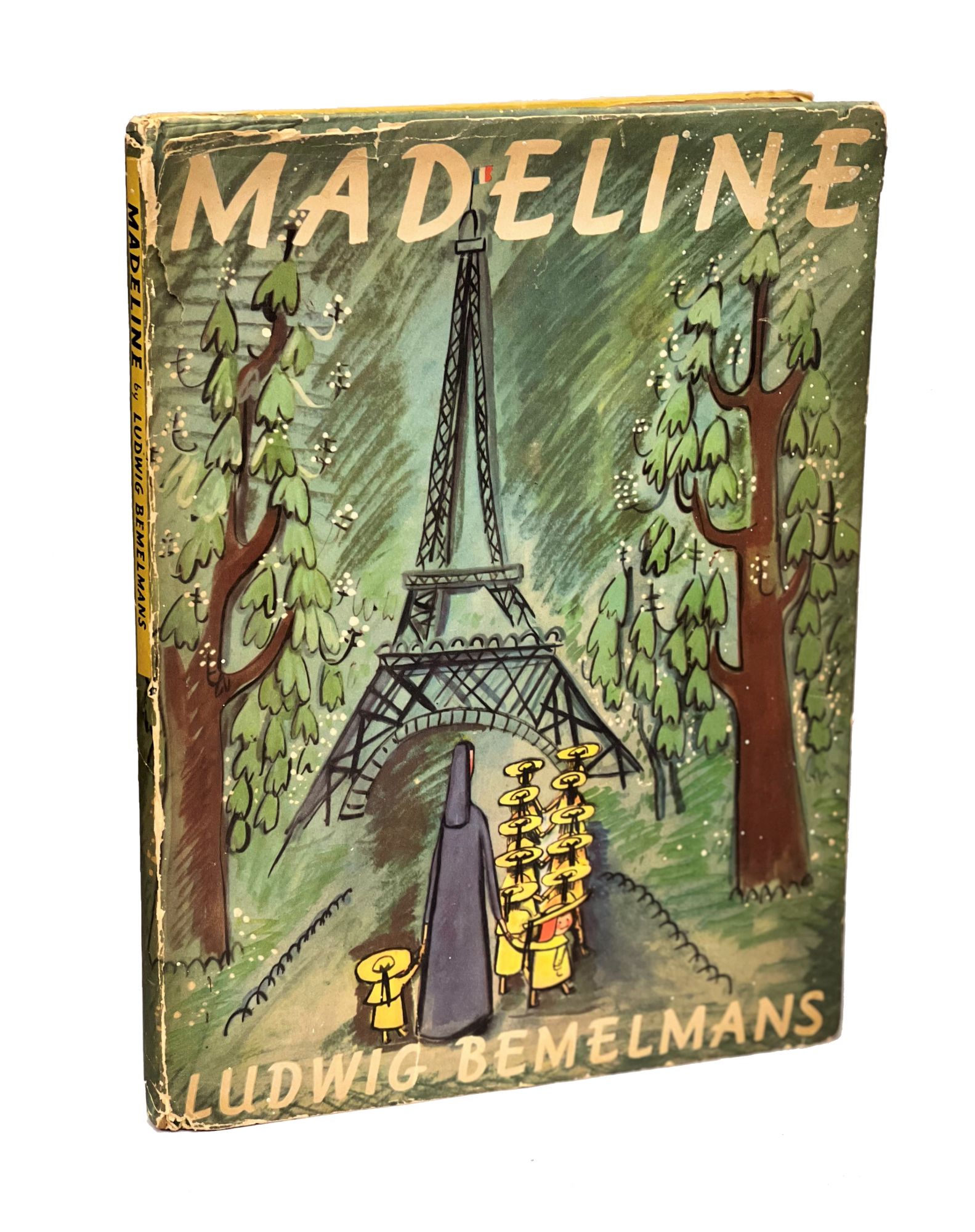
New York: Simon & Schuster, 1939. Illustrated by Bemelmans. First edition, first printing. Originalpublisher's paper-covered illustrated boards in a matching illustrated first issue dust jacket. Very goodbookwith light wear to top and bottom edges and spine ends, and a bit of offsetting to endpapers; verygood unclipped dust jacket with some chipping and wear to edges and spine hinges, small chip to foot ofspine, a couple of closed tears to spine hinges, somesoiling to rear panel, a bit of toning to front panel andspine. A very good copy overall, with remarkably bright illustrations. This beloved children's story is thefirst in a series of eleven books featuring the young protagonist Madeline. Set in a Catholic boardingschool in Paris, the story begins when Madeline is rushed to the hospital with a ruptured appendix. AfterMadeline recuperates and returns to school, the other children are fascinated by her scar, endearinglyhoping that they might also havethe same surgery. Although Bemelmans published other books,Madeline remains his best-known work. Notably, Bemelmans authored only the first six books in theMadeline series; after his death, the story was kept alive through five more books published by his grandson, John Bemelmans Marciano. Madeline was awarded the Caldecott Honor in 1940, and remainsa classic in the genre of children's literature.
Offered by B&B Rare Books (booth B6).
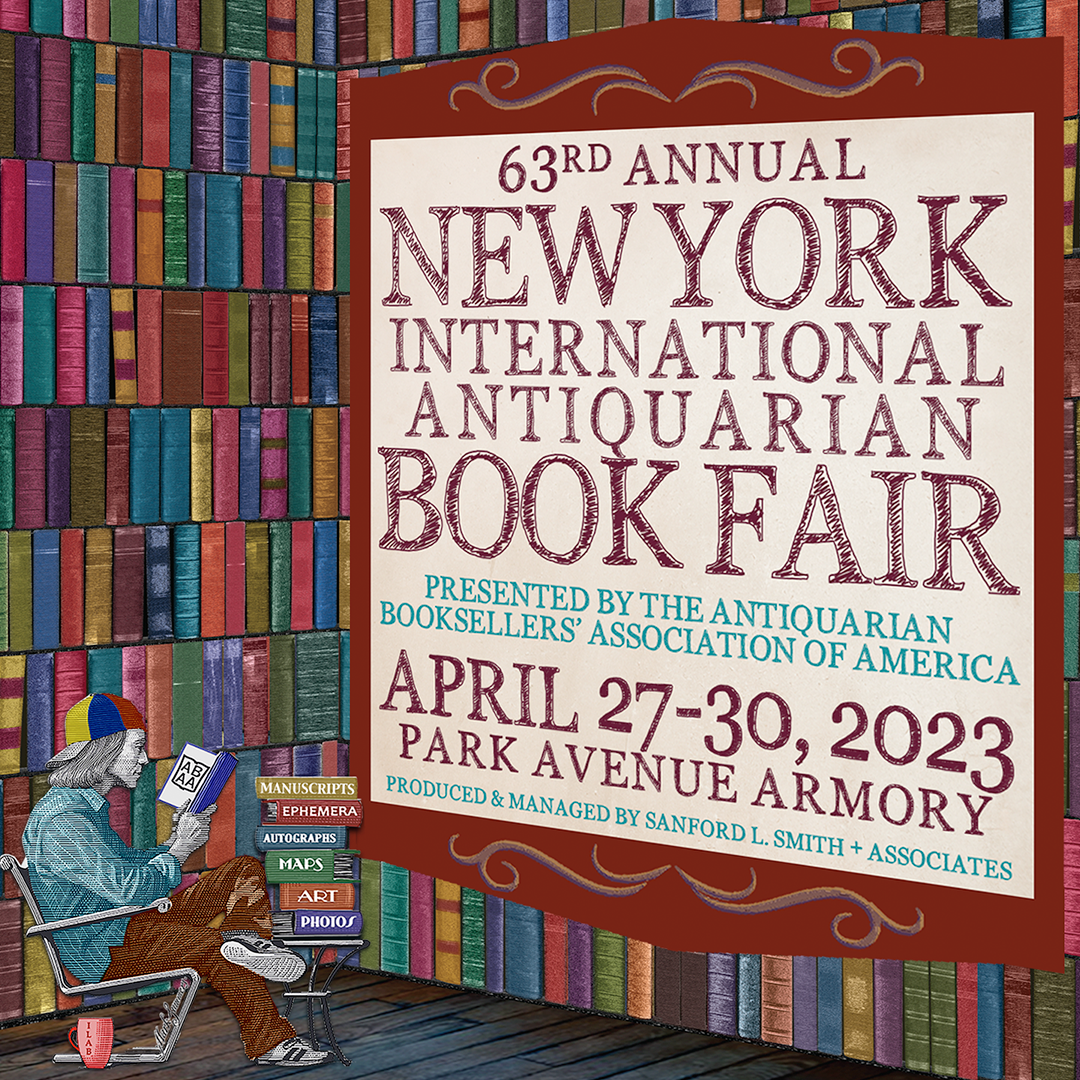
Learn more about the New York International Antiquarian Book Fair or buy tickets...


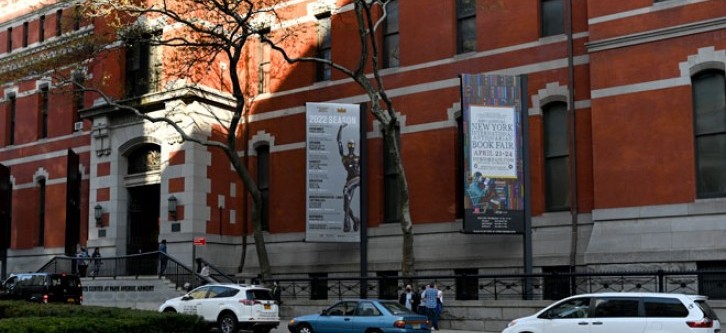










.jpg)

.jpg)












